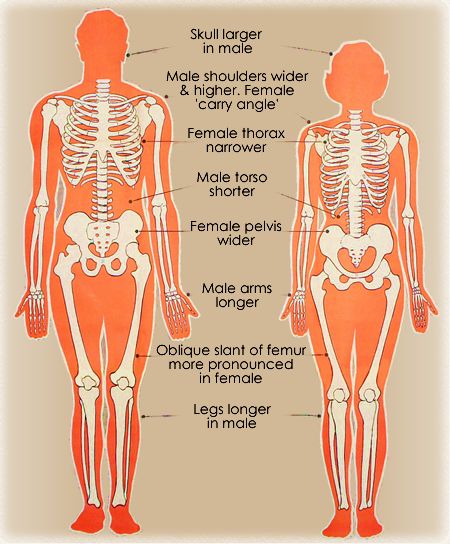Explain Three Differences Between Male and Female Skeletons
Specifically type-I fibers are 19 larger type-IIA fibers are 59 larger and type-IIX fibers are 66 larger in men than in women normalized to total biopsy section analyzed 89. Female pelvis has a shallow pelvic cavity and it is wider than male pelvis.
Difference Between Male And Female Skeleton Pediaa Com
The female skeleton has a wider breast bone and narrower.
. Because her orientation is inward toward relationships nurturing and nesting the female of the species puts a premium on safety and security. Several general differences exist between the male and female skeletons. The length of the femur tibia humerus and radius are normally longer in a male.
There are major differences between female and male skeletal muscles including differences in energy metabolism fiber type composition and contractile speed 7 11 19 23 33. Pubic arch- narrow sharper angle. Acetabulum of male pelvis is larger while that of female pelvis is smaller.
Male bones are longer thicker and more robust. Subtle differences are detectable but they become more defined following puberty and sexual. Difference Between Male and Female Skeleton Bones in the female body complete their development sooner than those in the male body.
What are the skeletal differences between these two pelvesIn anatomy labs for nursing school and other health science majors. Has a sacrum that is wider shorter and less curved. The three main points are shoulder width rib cage and pelvis.
As mentioned earlier studies of vastus lateralis biopsies show fiber-type CSA to be larger in men than in women. The most important difference between the male and female skeletons is found at the level of the pelvis. One of the most significant differences between male and female skeletons is body size and bone size.
Male vs Female Sacrum. Greater Sciatic Notch Acetabula and Ischial Tuberosities. Sacrum Has a longer and narrower sacrum.
A female pelvis has a large circular pelvic inlet compared to a males narrower heart-shaped pelvic inlet. Both skeletons are made up of 206 bones. In females the bones complete their development around the age of 18 whereas in males the bones continue to grow.
Hip bones heavier thicker more evidence of muscle attachment. The male skeleton is generally larger and heavier than the female. Structural differences between the male and female skeletal systems are also evident in the skull.
How to draw men and women 1. However the biggest difference is in the pelvis. These differences become evident at birth and continue throughout childhood.
Obturator foramen of male pelvis is round while in females it is oval. Female skeleton contains smaller lighter. The major difference between female and male skeletons is in the pelvis which is due to another major difference between men and women--childbirth.
A female has a broader sciatic notch and her hip bones are flared. Also the existence of a well-defined ventral arc helps to identify female remains. Similarities Between Male and Female Skeleton.
The coccyx bone of the male curves more toward the front of the body in comparison to the females coccyx. The main function of both skeletons is the provide support to the body while allowing movement. The coccyx or tailbone which is the last bone of the spinal column is more movable in female skeletons.
The bony mass or the thickness of the bone. The female pelvis is smaller shallower and wider and the cavity is more circular in shape. Pelvic InletBrim Has a heart-shaped pelvic inlet.
In this article I will explain how to draw the whole body of men and women focusing on the differences in their skeletons. The female pelvis is adapted for gestation. Wider sub-pubic angle where the two bones meet.
Men tend to have longer and thicker femurs than women. Generally male muscles have a higher capacity for anaerobic metabolism and generate a higher maximum power output than female muscles. Female pelvis is bigger and wide with lighter and denser bones.
Narrower sub-pubic angle where the two bones meet. The sacrum of the female is wider and the pelvic ring is wider and more circular to facilitate the passage of the newborn. The forehead is vertical.
Male Skulls Generally larger than female Larger brow ridges with sloping less rounded forehead Greater definition of muscle attachment areas on the back of the head Larger projections behind the ears mastoid processes Square chin with a more. In males the forehead is slightly sloping or receding. Vault of the skull.
In males the skull size is larger than that in females. Size Male pelvis is smaller and narrower with heavier and thicker bones. In general the clavicle length is longer in men than.
Male pelvic cavities in contrast are not as shallow. Female pelvic regions are more circular and the pelvic bone is smaller and wider. Skull has multiple differences.
Smaller compared to that in males. Sex-related skeletal features are not obvious in childrens bones. Such as the male has an overbite compared to the female and the size is bigger.
Obturator foramen- more oval. Further and more significant bone structure differences will. The sacrum of the female is shorter wider and has a greater curve whereas the male sacrum is thinner longer and is less curved.
It is not as high and is proportionately wider than that of the male. They mainly contain a skull rib cage pelvis and limbs. The pelvis on a female skeleton is larger and more open the direct result of the childbearing role.
Shoulder width The first difference between men and womens physiques is shoulder width. Male and female skeleton are the two types of skeletons classified based on the sex. Subpubic arch of male pelvis is more acute while that of female pelvis is wider.
To a far greater extent than the male she values qualities like dependability and trustworthiness in a potential mate.
Differences Between Male And Female Skeletons

Differences Between Male And Female Skeletons R Menwritingwomen

Differences Between Male And Female Skeletons Heads And Muscles
No comments for "Explain Three Differences Between Male and Female Skeletons"
Post a Comment